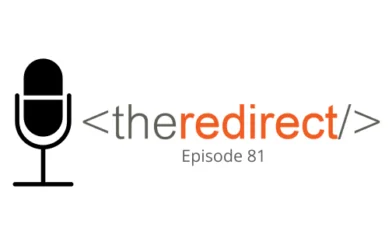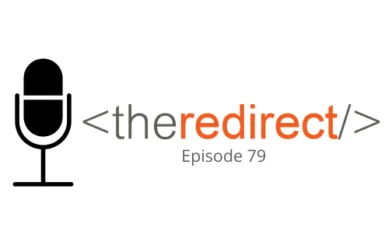Episode 45 / May 11, 2018
Listen now:
Welcome to The Redirect Podcast, where the BlackTruck team shares recent insights and takeaways from the world of search marketing.
In this week’s episode:
- WordStream, a highly-respected PPC management platform was acquired by news publisher Gannett this week (begins at 2:06).
- For those who missed it, we dive into Google I/O and highlight the key elements that search marketers should be paying attention to. Spoiler: It’s centered around site performance for your users and the engines. (begins at 18:07).
- A more unsettling update from Google I/O came with the announcement and demonstration of “Duplex” (begins at 14:10).
- More changes to Google AdWords with the beta testing of expanded responsive text ads for search, meaning more real estate taken up by ads (begins at 10:03).
- On a more somber note, the social media grading tool Klout is no longer, and it will be phased out this year. What was YOUR Klout score? Is anyone going to miss Klout? (begins at 4:10).
Updates from Google I/O
Emphasis on Site Performance
For those of you not paying attention to the tech industry this week, Google I/O happened. I/O is the annual two-day developer conference where Google shares all of their product updates and soon-to-come rollouts. This is an event that actually is becoming much larger than even Apple product announcements.
Google posted up on the Webmasters blog all of the sessions that SEOs should pay attention to. Much of these centered around security, web performance and load times, web accessibility, and leveraging AMP and Firebase for faster sites. Plus, using tools such as Lighthouse and Chrome UX Report for monitoring web performance.
Notice a trend here? Performance. We’ve stated it before: 2018 is the year for mobile-first indexing, and focusing time and attention on performance is well worth the effort.
Modern JavaScript-powered sites deliver a great engaging user experience, but the interface will use a single HTML file, and then pull in the details via JavaScript. Therein lies the problem for search. Many times, these frameworks will kick back empty responses to search engines, meaning the “indexability” of the site is poor.
Remember, the goal is to ensure an engine can understand what your site/page is about. Google is making some changes on how they process JavaScript-heavy pages. They currently handle it in two phases. An initial crawl, then a second one a couple of days later that ends up rendering all of the JavaScript. This can leave out really great pieces of content and information for search and the user.
Google will roll out what is called Dynamic Rendering during a session on search-friendly JavaScript sites.
“In a nutshell, dynamic rendering is the principle of sending normal client-side rendered content to users and sending fully server-side rendered content to search engines and to other crawlers that need it.” —John Mueller
Mariya Moeva and John Mueller also presented on something more basic, centered around how the way a site is built out can improve its presence for search. They covered everything from hosting, CMS, plugins, structured data, etc. Mueller went on to mention they (Google) didn’t feel they typically give developers much insight on what makes a site more search-friendly. Perhaps they (developers) need to work more closely with search marketing professionals?
Google Duplex Does What?
A development announced at I/O that has been causing much chatter this week was Google Duplex, which functions within Google Assistant to “help you make reservations, schedule appointments, and get holiday hours from businesses. Just provide the date and time, and your Assistant will call the business to coordinate for you.” We listened to the demonstration and were unsettled by how human the Assistant sounded—complete with “um” and “ahh…” verbal pauses—in a very realistic-sounding conversation between the person receiving the call and, essentially, a robot.
Perceptions of Duplex have ranged from it being anywhere between a very helpful tool and an ethical nightmare, as it seems the person on the other end of the call has no idea they’re not talking to a real person. (However, Google has apparently said that it’s designing Duplex “with disclosure built-in.”)
While this capability will be tested this summer, it points to what may soon be available en masse and used by searchers who are using Google Assistant. Google My Business has been adding features to the platform in the last year, like the ability to book appointments, which is likely what Duplex will use for these kinds of user requests.
So…anyone else reminded of Westworld?
Google AdWords Expands Responsive Search Ads Format
Google has announced beta testing of a new search ad format that will take up more real estate on the page—always a plus when it comes to getting ads seen. Current expanded text ads are two “titles” long. Responsive text ads are currently in beta, being tested at 3 titles long, with an additional 10 characters in the long description, bringing it to 90 characters over the existing 80.
The purpose of these expanded responsive ads is to eliminate manual A/B testing in the long run, focusing on a machine learning element. With these new responsive ads, you have the ability to define 15 headlines and four descriptions, and the AI will create the ads in real time.
You can also “pin” different headlines with descriptions, which could prove beneficial in making sure different titles and descriptions aren’t redundant with each other.
Since this is currently only available in beta responsive text ads, there’s no indication that these won’t also become available in standard text ads in the future.
It’s also important to note that these ads are specifically for search ads, and not display, where responsive ads have generally been most used in the past.
One of the metrics that will be reviewed by AdWords (not the advertisers) is to see if your ad groups will have a greater ability to compete across more auctions, causing more keyword triggering of your ads.
R.I.P. Klout
The technology company Lithium made the decision this week to sunset the Klout service effective May 25, 2018 (coincidently the same effective date GDPR becomes enforced), saying “Klout as a standalone service is not aligned with our long-term strategy.”
Klout was acquired by Lithium in 2014, with the idea that it would bring Klout members together with the 100 million other Lithium consumers for a very big data footprint over about 600-700 million users. This partnership, which was sorta the early “influencer relations” space for marketing and communication pros, was really building on this idea of third party credibility for a more trusted measure of reputation for everyday transactions—much like blockchain technology, the key technology behind Bitcoin, is doing today.
For those of you who don’t remember Klout, The Guardian breaks it down: “Klout was a slightly different social media tool, in that it analysed your Twitter and Facebook accounts for followers, retweets, shares, and mentions, and then awarded you a ‘Klout score’—a number between one and 100—that reflected how influential you were.” BTM’s Patrick thinks Klout sounds a little “Black Mirror”-esque, and he’s not wrong: Boiling down the entirety of your online social engagement to a mere number frankly was a little, as critics said, “socially evil.”
So what’s next for Lithium? Well, the company memo sunsetting Klout points to more development in artificial intelligence (AI), machine learning, and also a new “social impact scoring methodology based on Twitter.” But what I (and others) really want to know is: Where is all that data they collected gonna go, and who will be using it?
Don’t remember what you were considered “influential” in when Klout was in its heyday? You have a few weeks to get your score updated and find out: Visit klout.com.
Thanks for tuning in! To catch future episodes of The Redirect Podcast, subscribe on SoundCloud, iTunes, or Stitcher.




